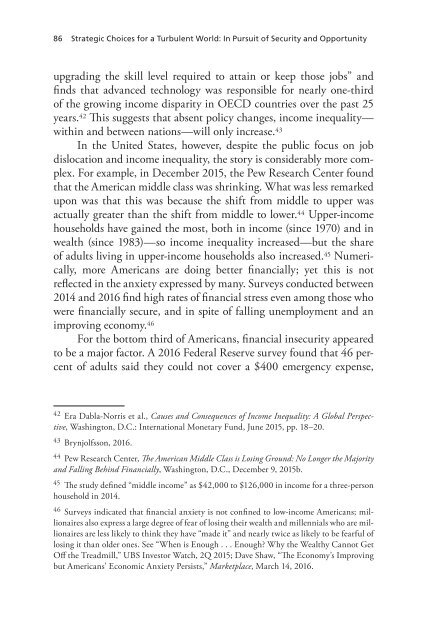You also want an ePaper? Increase the reach of your titles
YUMPU automatically turns print PDFs into web optimized ePapers that Google loves.
86 Strategic Choices for a Turbulent World: In Pursuit of Security and Opportunity<br />
upgrading the skill level required to attain or keep those jobs” and<br />
finds that advanced technology was responsible for nearly one-third<br />
of the growing income disparity in OECD countries over the past 25<br />
years. 42 This suggests that absent policy changes, income inequality—<br />
within and between nations—will only increase. 43<br />
In the United States, however, despite the public focus on job<br />
dislocation and income inequality, the story is considerably more complex.<br />
For example, in December 2015, the Pew Research Center found<br />
that the American middle class was shrinking. What was less remarked<br />
upon was that this was because the shift from middle to upper was<br />
actually greater than the shift from middle to lower. 44 Upper-income<br />
households have gained the most, both in income (since 1970) and in<br />
wealth (since 1983)—so income inequality increased—but the share<br />
of adults living in upper-income households also increased. 45 Numerically,<br />
more Americans are doing better financially; yet this is not<br />
reflected in the anxiety expressed by many. Surveys conducted between<br />
2014 and 2016 find high rates of financial stress even among those who<br />
were financially secure, and in spite of falling unemployment and an<br />
improving economy. 46<br />
For the bottom third of Americans, financial insecurity appeared<br />
to be a major factor. A 2016 Federal Reserve survey found that 46 percent<br />
of adults said they could not cover a $400 emergency expense,<br />
42 Era Dabla-Norris et al., Causes and Consequences of Income Inequality: A Global Perspective,<br />
Washington, D.C.: International Monetary Fund, June 2015, pp. 18–20.<br />
43 Brynjolfsson, 2016.<br />
44 Pew Research Center, The American Middle Class is Losing Ground: No Longer the Majority<br />
and Falling Behind Financially, Washington, D.C., December 9, 2015b.<br />
45 The study defined “middle income” as $42,000 to $126,000 in income for a three-person<br />
household in 2014.<br />
46 Surveys indicated that financial anxiety is not confined to low-income Americans; millionaires<br />
also express a large degree of fear of losing their wealth and millennials who are millionaires<br />
are less likely to think they have “made it” and nearly twice as likely to be fearful of<br />
losing it than older ones. See “When is Enough . . . Enough? Why the Wealthy Cannot Get<br />
Off the Treadmill,” UBS Investor Watch, 2Q 2015; Dave Shaw, “The Economy’s Improving<br />
but Americans’ Economic Anxiety Persists,” Marketplace, March 14, 2016.




